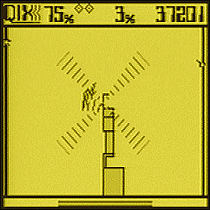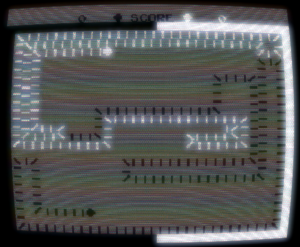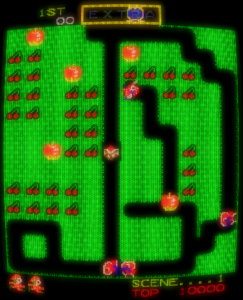 The Game: You are a marker, trying to claim as much of the playing field as you can by enclosing areas of it. Drawing your boundaries faster is safer, but yields fewer points. A slower draw, which leaves you vulnerable to attack from the Qix and the Sparx, gives you many more points upon the completion of an enclosed area. If the ever-shifting Qix touches your marker or an uncompleted boundary you are drawing, you lose a “life” and start again. And the Sparx, which travel only along the edges of the playing field and along the boundaries of areas of the screen you’ve already enclosed, can destroy you by touching your marker. And if you linger too long, a fuse will begin burning at the beginning of your unfinished boundary, and will eventually catch up with you. (Nintendo/Taito, 1990)
The Game: You are a marker, trying to claim as much of the playing field as you can by enclosing areas of it. Drawing your boundaries faster is safer, but yields fewer points. A slower draw, which leaves you vulnerable to attack from the Qix and the Sparx, gives you many more points upon the completion of an enclosed area. If the ever-shifting Qix touches your marker or an uncompleted boundary you are drawing, you lose a “life” and start again. And the Sparx, which travel only along the edges of the playing field and along the boundaries of areas of the screen you’ve already enclosed, can destroy you by touching your marker. And if you linger too long, a fuse will begin burning at the beginning of your unfinished boundary, and will eventually catch up with you. (Nintendo/Taito, 1990)
Memories: One of the few completely abstract arcade games ever to catch on with the public, Qix is very hard to get wrong, and this adaptation – an early first-party Game Boy cartridge patterned after a similarly first-person NES version – certainly doesn’t get it wrong. It’s pure Qix, without any added bull about having to uncover a picture by claiming area on the playfield.
Very little has actually changed from the arcade  edition – the sounds are markedly different, but even without the lightsaber-like hum of the enemy in arcade Qix, this version is charming enough.
edition – the sounds are markedly different, but even without the lightsaber-like hum of the enemy in arcade Qix, this version is charming enough.
For nearly 20 years, I’ve been completely mystified by the odd little “serenade scenes” that are shown along with your final score. I’m no closer to figuring out what a sombrero-wearing minstrel playing a song to a vulture has to do with Qix. Ah well, it’s cute enough.
 In 1990, this edition of Qix was one of the earliest indicators that the original monochrome Game Boy had something to offer to an old-school Atari-era gamer like myself.
In 1990, this edition of Qix was one of the earliest indicators that the original monochrome Game Boy had something to offer to an old-school Atari-era gamer like myself.  Indeed, I didn’t really properly hone my Qix skills until this cartridge arrived, so it’s a sentimental favorite.
Indeed, I didn’t really properly hone my Qix skills until this cartridge arrived, so it’s a sentimental favorite.


